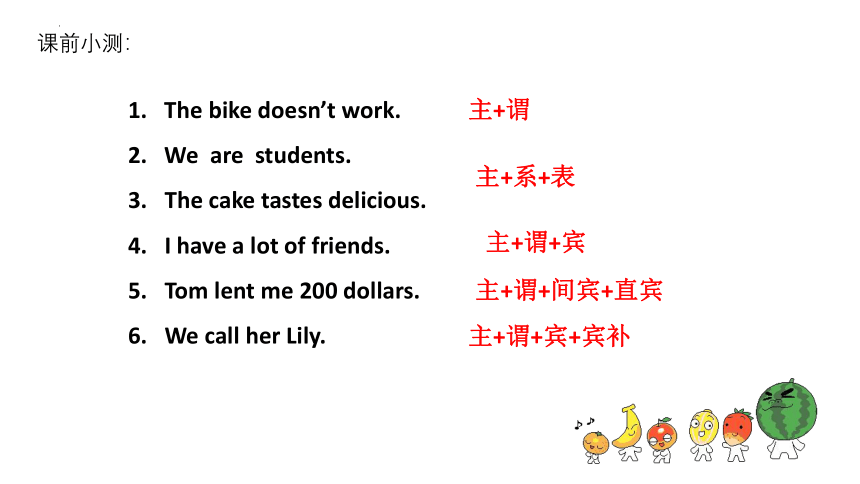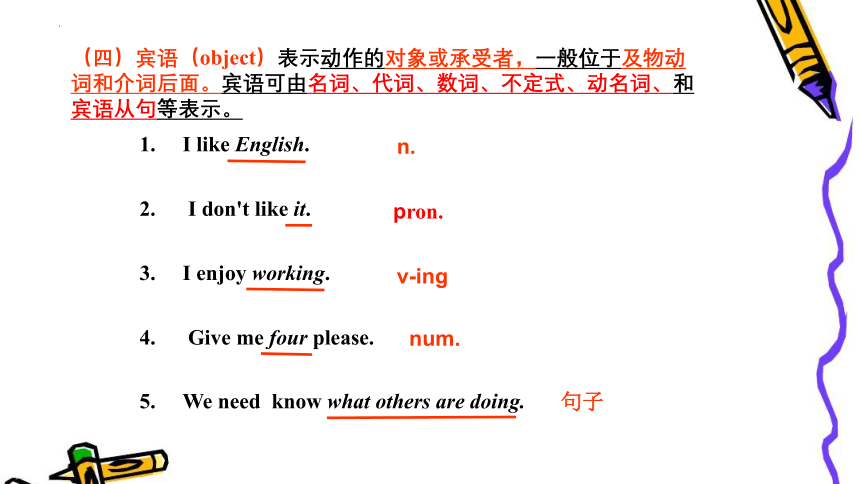-2023-2024学年高中英语句子成分及基本句型课件(共27张PPT)
文档属性
| 名称 | -2023-2024学年高中英语句子成分及基本句型课件(共27张PPT) |  | |
| 格式 | pptx | ||
| 文件大小 | 385.7KB | ||
| 资源类型 | 教案 | ||
| 版本资源 | 通用版 | ||
| 科目 | 英语 | ||
| 更新时间 | 2023-08-21 12:43:10 | ||
图片预览









文档简介
(共27张PPT)
句子成分及基本句型
The bike doesn’t work.
We are students.
3. The cake tastes delicious.
4. I have a lot of friends.
5. Tom lent me 200 dollars.
6. We call her Lily.
主+谓
主+系+表
主+谓+宾
主+谓+间宾+直宾
主+谓+宾+宾补
课前小测:
一、句子成分
members of a sentence
句子成分 意义 充当词类 例句
主语 表示句子说的是什么人或什么 事 名,代,数,不定 式,动名词,短语或 句子 We study in No.11 Middle
School.
谓语 说明主语做什么,是什么或怎 么样 动词或动词词组 She is dancing under the tree.
宾语 表示动作行为的对象 同主语 Both of us like English.
表语 与连系动词连用,一起构成谓 语,说明主语的性质或特征 同主语 Her father is a doctor.
His words sound reasonable.
定语 用来修饰名词或代词 形,代,数,名, 副,介词短语或句子 We have eight lessons every day.
状语 修饰动词,形容词,副词或句子表示动作发生的时间,地点,原因,目的,方式,结果等 副词,介词短语或句 子 He works very hard.
They held a party in Hollywood.
补语 补足主语和宾语的意义 形容词,名词,介词 短语等 She always keeps the house
clean.
同位语 在名词或代词之后,对前者加以说明的成分 名词 My hometown, Chongqing, is very beautiful.
主谓是基础,宾表定状补辅助。宾主来自名代数,动词作谓不可无!
简单句的五种基本句型:
主语+谓语+宾语
主语+谓语+间接宾语+直接宾语
3. 主语+谓语+宾语+宾语补足语
动词
系动词
不及物动词
及物动词
主语+系+表语
主语+谓语
What happened
He worked hard today.
Action speaks louder than words.
He can speak English well.
She doesn’t like dancing.
Tom is doing his homework now.
(二)谓语(predicate)说明主语所做的动作或具有的特征和状态。动词在句中作谓语,一般放在主语之后。
简单谓语:由动词或动词短语构成
复杂谓语:由“助动词/情态动词/be 动词+动词”组成
Walls have ears.
He will take you to the hospital.
Three plus four equals seven.
Smoking is bad for you.
(一)主语(subject)是一个句子所叙述的主体,一般位于句首。表示句子说的是什么人或什么事。但在there be结构、疑问句(当主语不是疑问词时)和倒装句中,主语位于谓语、助动词或情态动词后面。主语可由名词、代词、数词、不定式、动名词、名词化的形容词和主语从句等表示。
名词
代词
数词
动名词
My father is a teacher.
Who's that It's me.
He fell sick.
His hobby is playing basketball
His plan is to seek work in the city.
(三)表语(predicative)用来说明主语的性质、特征、状态、身份等,位于系动词之后。一般由名词、代词、数词、形容词、 副词、不定式、动名词、分词、介词短语及表语从句表示。
n.
pron.
adj.
doing.现在分词
to do不定式
I like English.
I don't like it.
I enjoy working.
Give me four please.
We need know what others are doing.
(四)宾语(object)表示动作的对象或承受者,一般位于及物动词和介词后面。宾语可由名词、代词、数词、不定式、动名词、和宾语从句等表示。
n.
pron.
v-ing
num.
句子
Mary is a beautiful girl.
They are women workers.
Tom’s father is a teacher.
Those who want to go to Tibet are to sign their names here.
5. He is a boy in Class 6.
(五)定语(attribute):修饰名词或代词,
单词作定语通常放在所修饰的名词之前,前置定语
短语或从句做定语时则放在名词之后。后置定语
形容词 adj.
名词 n.
名词所有格
介词短语作后置定语
常见作定语:形容词、名词、名词所有格、介词短语、定语从句、非谓语(doing、done、to do)
定语从句
5. He is a girl working hard.
It is a book written by Tom.
I have nothing to eat.
doing非谓作后置定语
done非谓作后置定语
to do非谓作后置定语
(六)状语(adverbial ):修饰动词、形容词、副词以及全句,表示动作发生的地点、时间、原因、目的、结果、条件、让步、伴随情况等。
常见作状语:副词、介词短语、非谓语(doing、done、to do)、
状语从句
when/while/as …时间状语从句
because/as/since …原因状语从句
although/though…让步状语从句
if/once/unless… 条件状语从句
I left the village five years ago.
I arrived late because of the traffic jam .
We will send a car to fetch you.
The fish can eat a person in two minutes , leaving only bones.
The students came into the classroom, singing and dancing.
Encouraged by his words, I decide to work harder.
7. If he goes, so will I
to do作目的状语
时间状语
原因状语
doing作结果状语
doing作伴随状语
条件状语从句
done作原因状语
We try to make our country strong.
We found everything in good order there.
I should advise you to get the chance.
I saw him going upstairs.
They found the house broken in.
形容词
介词短语
to do 不定式
现在分词 doing
过去分词 done
(七)补语( complement):补充说明主语/宾语的意义
(八)同位语( apposition):在名词或代词之后,对前者加以说明的成分
Mr smith,our new teacher,is very kind to us.
Yesterday I met Tom, a friend of my brother's.
二、sentence patterns
主语 S(subject)
谓语 V (verb)
宾语 O (object)
表语 P (predictive)
直宾 DO (direct object)
间宾 IO (indirect object)
宾补 OC (object complement )
状语 Ad(adverbial)
定语 At (attributive)
简单句的五种基本句型:
主语+谓语+宾语
主语+谓语+间接宾语+直接宾语
3. 主语+谓语+宾语+宾语补足语
动词
系动词
不及物动词
及物动词
主语+系+表语
主语+谓语
(S+ link V+P)
(S+Vi)
(S+ Vt + O)
(S+ Vt + IO+ DO)
S+ Vt+ O+ OC)
3. 主+系+表( S+Link.V+P ),说
明主语的特征、类属、状态、身份。
You are students.
He looks different.
The food goes bad.
系动词
1. 状态类:be动词
2.表象类:seem,appear...
appear blue
seem happy
3.感官类:look,smell, taste, sound, feel
look tired
smell sweet
taste good
feel smooth feel hungry
sound sweet
系动词
4.变化类:become, get, turn,
go, grow fall
get.:get warm (自然现象);get angry (心情)
become:become angry (心情); become a teacher(职业)
turn:turn green (颜色); turn teacher (职业); turn 16(年龄)
grow:grow tall (生命)
go:go bad (贬义)
fall:fall ill生病, fall asleep入睡
系动词
5.持续类:remain, stay, keep, continue
remain保持:remain young.
stay保持: stays the same
keep保持: keep quiet
continue保持: continue hot
6.结果类:turn out, prove
proves good
turn out an honest boy
1)Everything changes.
2)The sun rises.
3)Who cares
S
Vi
S
vi
1. 主+谓 (S+ Vi)
S
vi
2. 主+谓+宾 (S+ Vt + O)
1)She likes her work.
2)Few students like taking exams.
3)We love our country.
4)He enjoys reading.
S
Vt
O
S
S
S
Vt
Vt
Vt
O
O
O
4.主+谓+双宾 (S+ Vt + IO+ DO)
1) She teaches us English.
2)Grandma cooked us a nice meal.
3)She gave the baby a bath.
4)The boy asked me if I could speak Chinese.
Vt
S
IO
DO
Vt
S
IO
DO
Vt
S
IO
DO
Vt
S
IO
DO
5.主+谓+宾+宾补 (S+ Vt+ O+ OC)
1) Her lessons make us happy.
2)I found this book easy.
3)I saw a cat running across the road.
4)They painted the door green.
S
Vt
O
OC
S
S
S
Vt
Vt
Vt
O
O
O
OC
OC
OC
1. I can swim.
2. I like English.
3. They are reading books .
4. He bought a computer last week.
5. My mother is a scientist.
The food goes bad.
7. My mother bought me a dictionary yesterday.
Exercises:指出下列句子的基本句型
句子成分及基本句型
The bike doesn’t work.
We are students.
3. The cake tastes delicious.
4. I have a lot of friends.
5. Tom lent me 200 dollars.
6. We call her Lily.
主+谓
主+系+表
主+谓+宾
主+谓+间宾+直宾
主+谓+宾+宾补
课前小测:
一、句子成分
members of a sentence
句子成分 意义 充当词类 例句
主语 表示句子说的是什么人或什么 事 名,代,数,不定 式,动名词,短语或 句子 We study in No.11 Middle
School.
谓语 说明主语做什么,是什么或怎 么样 动词或动词词组 She is dancing under the tree.
宾语 表示动作行为的对象 同主语 Both of us like English.
表语 与连系动词连用,一起构成谓 语,说明主语的性质或特征 同主语 Her father is a doctor.
His words sound reasonable.
定语 用来修饰名词或代词 形,代,数,名, 副,介词短语或句子 We have eight lessons every day.
状语 修饰动词,形容词,副词或句子表示动作发生的时间,地点,原因,目的,方式,结果等 副词,介词短语或句 子 He works very hard.
They held a party in Hollywood.
补语 补足主语和宾语的意义 形容词,名词,介词 短语等 She always keeps the house
clean.
同位语 在名词或代词之后,对前者加以说明的成分 名词 My hometown, Chongqing, is very beautiful.
主谓是基础,宾表定状补辅助。宾主来自名代数,动词作谓不可无!
简单句的五种基本句型:
主语+谓语+宾语
主语+谓语+间接宾语+直接宾语
3. 主语+谓语+宾语+宾语补足语
动词
系动词
不及物动词
及物动词
主语+系+表语
主语+谓语
What happened
He worked hard today.
Action speaks louder than words.
He can speak English well.
She doesn’t like dancing.
Tom is doing his homework now.
(二)谓语(predicate)说明主语所做的动作或具有的特征和状态。动词在句中作谓语,一般放在主语之后。
简单谓语:由动词或动词短语构成
复杂谓语:由“助动词/情态动词/be 动词+动词”组成
Walls have ears.
He will take you to the hospital.
Three plus four equals seven.
Smoking is bad for you.
(一)主语(subject)是一个句子所叙述的主体,一般位于句首。表示句子说的是什么人或什么事。但在there be结构、疑问句(当主语不是疑问词时)和倒装句中,主语位于谓语、助动词或情态动词后面。主语可由名词、代词、数词、不定式、动名词、名词化的形容词和主语从句等表示。
名词
代词
数词
动名词
My father is a teacher.
Who's that It's me.
He fell sick.
His hobby is playing basketball
His plan is to seek work in the city.
(三)表语(predicative)用来说明主语的性质、特征、状态、身份等,位于系动词之后。一般由名词、代词、数词、形容词、 副词、不定式、动名词、分词、介词短语及表语从句表示。
n.
pron.
adj.
doing.现在分词
to do不定式
I like English.
I don't like it.
I enjoy working.
Give me four please.
We need know what others are doing.
(四)宾语(object)表示动作的对象或承受者,一般位于及物动词和介词后面。宾语可由名词、代词、数词、不定式、动名词、和宾语从句等表示。
n.
pron.
v-ing
num.
句子
Mary is a beautiful girl.
They are women workers.
Tom’s father is a teacher.
Those who want to go to Tibet are to sign their names here.
5. He is a boy in Class 6.
(五)定语(attribute):修饰名词或代词,
单词作定语通常放在所修饰的名词之前,前置定语
短语或从句做定语时则放在名词之后。后置定语
形容词 adj.
名词 n.
名词所有格
介词短语作后置定语
常见作定语:形容词、名词、名词所有格、介词短语、定语从句、非谓语(doing、done、to do)
定语从句
5. He is a girl working hard.
It is a book written by Tom.
I have nothing to eat.
doing非谓作后置定语
done非谓作后置定语
to do非谓作后置定语
(六)状语(adverbial ):修饰动词、形容词、副词以及全句,表示动作发生的地点、时间、原因、目的、结果、条件、让步、伴随情况等。
常见作状语:副词、介词短语、非谓语(doing、done、to do)、
状语从句
when/while/as …时间状语从句
because/as/since …原因状语从句
although/though…让步状语从句
if/once/unless… 条件状语从句
I left the village five years ago.
I arrived late because of the traffic jam .
We will send a car to fetch you.
The fish can eat a person in two minutes , leaving only bones.
The students came into the classroom, singing and dancing.
Encouraged by his words, I decide to work harder.
7. If he goes, so will I
to do作目的状语
时间状语
原因状语
doing作结果状语
doing作伴随状语
条件状语从句
done作原因状语
We try to make our country strong.
We found everything in good order there.
I should advise you to get the chance.
I saw him going upstairs.
They found the house broken in.
形容词
介词短语
to do 不定式
现在分词 doing
过去分词 done
(七)补语( complement):补充说明主语/宾语的意义
(八)同位语( apposition):在名词或代词之后,对前者加以说明的成分
Mr smith,our new teacher,is very kind to us.
Yesterday I met Tom, a friend of my brother's.
二、sentence patterns
主语 S(subject)
谓语 V (verb)
宾语 O (object)
表语 P (predictive)
直宾 DO (direct object)
间宾 IO (indirect object)
宾补 OC (object complement )
状语 Ad(adverbial)
定语 At (attributive)
简单句的五种基本句型:
主语+谓语+宾语
主语+谓语+间接宾语+直接宾语
3. 主语+谓语+宾语+宾语补足语
动词
系动词
不及物动词
及物动词
主语+系+表语
主语+谓语
(S+ link V+P)
(S+Vi)
(S+ Vt + O)
(S+ Vt + IO+ DO)
S+ Vt+ O+ OC)
3. 主+系+表( S+Link.V+P ),说
明主语的特征、类属、状态、身份。
You are students.
He looks different.
The food goes bad.
系动词
1. 状态类:be动词
2.表象类:seem,appear...
appear blue
seem happy
3.感官类:look,smell, taste, sound, feel
look tired
smell sweet
taste good
feel smooth feel hungry
sound sweet
系动词
4.变化类:become, get, turn,
go, grow fall
get.:get warm (自然现象);get angry (心情)
become:become angry (心情); become a teacher(职业)
turn:turn green (颜色); turn teacher (职业); turn 16(年龄)
grow:grow tall (生命)
go:go bad (贬义)
fall:fall ill生病, fall asleep入睡
系动词
5.持续类:remain, stay, keep, continue
remain保持:remain young.
stay保持: stays the same
keep保持: keep quiet
continue保持: continue hot
6.结果类:turn out, prove
proves good
turn out an honest boy
1)Everything changes.
2)The sun rises.
3)Who cares
S
Vi
S
vi
1. 主+谓 (S+ Vi)
S
vi
2. 主+谓+宾 (S+ Vt + O)
1)She likes her work.
2)Few students like taking exams.
3)We love our country.
4)He enjoys reading.
S
Vt
O
S
S
S
Vt
Vt
Vt
O
O
O
4.主+谓+双宾 (S+ Vt + IO+ DO)
1) She teaches us English.
2)Grandma cooked us a nice meal.
3)She gave the baby a bath.
4)The boy asked me if I could speak Chinese.
Vt
S
IO
DO
Vt
S
IO
DO
Vt
S
IO
DO
Vt
S
IO
DO
5.主+谓+宾+宾补 (S+ Vt+ O+ OC)
1) Her lessons make us happy.
2)I found this book easy.
3)I saw a cat running across the road.
4)They painted the door green.
S
Vt
O
OC
S
S
S
Vt
Vt
Vt
O
O
O
OC
OC
OC
1. I can swim.
2. I like English.
3. They are reading books .
4. He bought a computer last week.
5. My mother is a scientist.
The food goes bad.
7. My mother bought me a dictionary yesterday.
Exercises:指出下列句子的基本句型
